
A diatom is any member of a large group comprising several genera of algae, specifically microalgae, found in the oceans, waterways and soils of the world. Living diatoms make up a significant portion of the Earth's biomass: they generate about 20 to 50 percent of the oxygen produced on the planet each year, take in over 6.7 billion tonnes of silicon each year from the waters in which they live, and constitute nearly half of the organic material found in the oceans. The shells of dead diatoms can reach as much as a half-mile deep on the ocean floor, and the entire Amazon basin is fertilized annually by 27 million tons of diatom shell dust transported by transatlantic winds from the African Sahara, much of it from the Bodélé Depression, which was once made up of a system of fresh-water lakes.
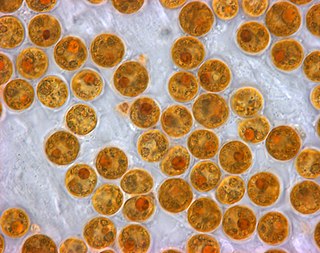
Zooxanthellae is a colloquial term for single-celled dinoflagellates that are able to live in symbiosis with diverse marine invertebrates including demosponges, corals, jellyfish, and nudibranchs. Most known zooxanthellae are in the genus Symbiodinium, but some are known from the genus Amphidinium, and other taxa, as yet unidentified, may have similar endosymbiont affinities. The true Zooxanthella K.brandt is a mutualist of the radiolarian Collozoum inerme and systematically placed in Peridiniales. Another group of unicellular eukaryotes that partake in similar endosymbiotic relationships in both marine and freshwater habitats are green algae zoochlorellae.

Kleptoplasty or kleptoplastidy is a process in symbiotic relationships whereby plastids, notably chloroplasts from algae, are sequestered by the host. The word is derived from Kleptes (κλέπτης) which is Greek for thief. The alga is eaten normally and partially digested, leaving the plastid intact. The plastids are maintained within the host, temporarily continuing photosynthesis and benefiting the host.

The blurred lanternshark is a little-known species of dogfish shark in the family Etmopteridae, found around the world in benthic and pelagic habitats from a depth of 110 m (360 ft) to over 1 km (0.62 mi) down. This shark forms the E. pusillus species group with the smooth lanternshark, which are distinguished from other members of its family by having irregularly arranged, flat-topped dermal denticles that give them a "smooth" appearance. Both species are slender-bodied with long heads, two dorsal fins bearing spines, no anal fins, and light-emitting photophores. The blurred lanternshark is larger, reaching 67 cm (26 in) or more in length. This species feeds on small squid, fishes, and fish eggs, and is ovoviviparous. It has been assessed as of Least Concern by the International Union for Conservation of Nature, because of its wide distribution and lack of threat from fishing pressure.

The Coscinodiscophyceae are a class(s) of diatoms. They are similar to the Centrales, a traditional, paraphyletic subdivision of the heterokont algae known as diatoms. The order is named for the shape of the cell walls of centric diatoms, which are circular or ellipsoid in valve view. The valves often bear radially symmetrical ornamental patterns that can appear as dots when viewed with an optical microscope. Some also bear spines on their valves, which may either increase cell surface area and reduce sinking, or act as a deterrent to zooplankton grazers. Unlike pennate diatoms, centric diatoms never have a raphe.
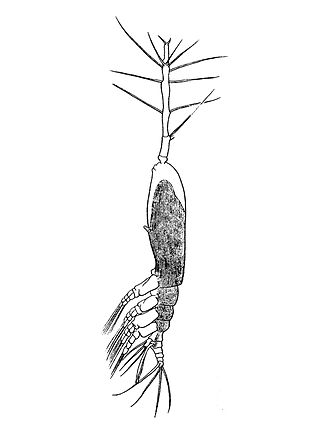
Monstrilloida is an order of copepods with a cosmopolitan distribution in the world's oceans. The order contains a single family, Monstrillidae. The name of the first ever described genus Monstrilla is derived from latin, meaning "tiny monster", because the lack of usual diagnostic features of copepods puzzled early taxonomists.
Dictyochloropsis is a genus of unicellular green alga of the phylum Chlorophyta. This genus consists of free-living algae which have a reticulate (net-like) chloroplast that varies slightly in morphology between species, and that when mature always lacks a pyrenoid. Dictyochloropsis is asexual and reproduces using autospores.

Rhodomonas is a genus of cryptomonads. It is characterized by its red colour, the square-shaped plates of its inner periplast, its short furrow ending in a gullet, and a distinctly shaped chloroplast closely associated with its nucleomorph. Historically, Rhodomonas was characterized by its red chloroplast alone, but this no longer occurs as its taxonomy has become increasingly based on molecular and cellular data. Currently, there is some debate about the taxonomic validity of Rhodomonas as a genus and further research is needed to verify its taxonomic status. Rhodomonas is typically found in marine environments, although freshwater reports exist. It is commonly used as a live feed for various aquaculture species.
Polarella is a dinoflagellate, and is the only extant genus of the Suessiaceae family. The genus was described in 1999 by Marina Montresor, Gabriele Procaccini, and Diane K. Stoecker, and contains only one species, Polarella glacialis. Polarella inhabits channels within ice formations in both the Arctic and Antarctic polar regions, where it plays an important role as a primary producer. Polarella is a thecate dinoflagellate, wherein the cell has an outer covering of cellulose plates, which are arranged in nine latitudinal series. The general morphology of Polarella is similar to that of a typical dinoflagellate. and Polarella has a zygotic life history, wherein it alternates between a motile vegetative phase and a non-motile spiny cyst. While it is thought that the cysts of Polarella have lost their ability to form fossils, the cyst life cycle stage has acted as link to extinct members of the Suessiaceae family.

Bacillaria is a diatom genus in the family Bacillariaceae.
Mesodinium chamaeleon is a ciliate of the genus Mesodinium. It is known for being able to consume and maintain algae endosymbiotically for days before digesting the algae. It has the ability to eat red and green algae, and afterwards using the chlorophyll granules from the algae to generate energy, turning itself from being a heterotroph into an autotroph. The species was discovered in January 2012 outside the coast of Nivå, Denmark by professor Øjvind Moestrup.
Durinskia is a genus of dinoflagellate that can be found in freshwater and marine environments. This genus was created to accommodate its type species, Durinskia baltica, after major classification discrepancies were found. While Durinskia species appear to be typical dinoflagellates that are armored with cellulose plates called theca, the presence of a pennate diatom-derived tertiary endosymbiont is their most defining characteristic. This genus is significant to the study of endosymbiotic events and organelle integration since structures and organelle genomes in the tertiary plastids are not reduced. Like some dinoflagellates, species in Durinskia may cause blooms.

DNA barcoding of algae is commonly used for species identification and phylogenetic studies. Algae form a phylogenetically heterogeneous group, meaning that the application of a single universal barcode/marker for species delimitation is unfeasible, thus different markers/barcodes are applied for this aim in different algal groups.
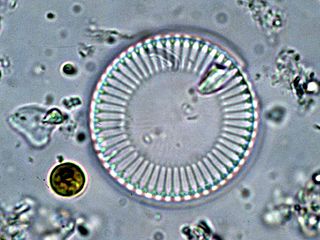
Cyclotella is a genus of diatoms often found in oligotrophic environments, both marine and fresh water. It is in the family Stephanodiscaceae and the order Thalassiosirales. The genus was first discovered in the mid-1800s and since then has become an umbrella genus for nearly 100 different species, the most well-studied and the best known being Cyclotella meneghiniana. Despite being among the most dominant genera in low-productivity environments, it is relatively understudied.
Leptocylindrus is a genus of diatoms belonging to the family Leptocylindraceae. They are long, cylindrical diatoms that are made up of multiple cells in a line. These cells have chloroplast to allow it to produce energy through photosynthesis by taking in sunlight and carbon dioxide to create sugars. the cells are attached at the cell walls called valves, the cell wall is slightly concave on one side and convex on the other so that the other cell wall attached will fit together.
Greta Albrecht Fryxell was a marine scientist known for her work on the biology and taxonomy of diatoms. In 1996, she was elected a fellow of the American Association for the Advancement of Science.
Linda Karen Medlin is a molecular biologist known for her work on diatoms. She is an elected member of the Norwegian Academy of Science and Letters.
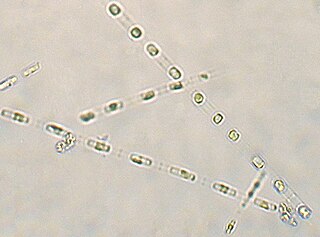
Skeletonema costatum is a cosmopolitan centric diatom that belongs to the genus Skeletonema. It was first described by R. K. Greville, who originally named it Melosira costata, in 1866. It was later renamed by Cleve in 1873 and was more narrowly defined by Zingone et al. and Sarno et al. Skeletonemacostatum is the most well known species of the genus Skeletonema and is often one of the dominant species responsible for red tide events.
Synchroma is a genus of marine stramenopile algae containing two species with amoeboid morphology. They are grouped within the monotypic family Synchromaceae and order Synchromales as part of an independent clade of ochrophytes known as Picophagea or Synchromophyceae.
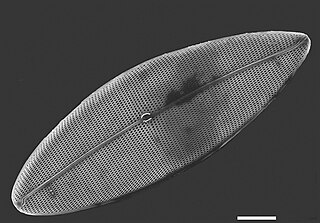
Pleurosigma pacificum is a species of planktonic diatom discovered in the tropical Western Pacific Ocean.












